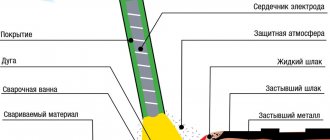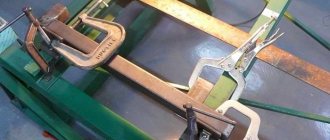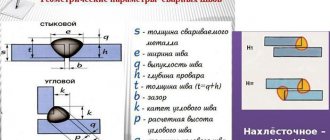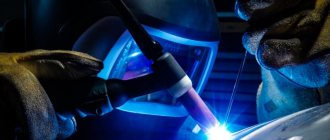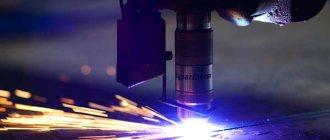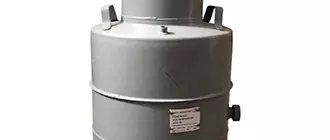general information
This method has additional international names; abbreviations are widely used in the manufacture of components. You can find - MMA (Manual Metal Arc - the literal translation of our term), the Russian abbreviation RDS, or in short - RD. The method was invented by Russian engineer Nikolai Bernardos, who subsequently improved his device and created varieties. The patent for the invention was purchased and introduced into the production of metal structures around the world. The classic material is a carbon electrode, but there are new inventions, methods that use melting rods.
Stages of the procedure
All professional and amateur welders operate according to the following algorithm:
- Preparation involves thoroughly cleaning all surfaces and securing the workpiece in the workplace.
- The appearance of an arc. For it to form, you need to apply voltage and touch the metal with the tip 2-3 times with quick movements.
- Carrying out a seam - speed and angle varies depending on the physical characteristics of the material.
- Final processing - unevenness should be removed, excess scale should be removed, and the joint should be cleaned.
Sometimes additional operations are required, such as preheating the workpiece or supplying shielding gas. However, the main elements of the algorithm are reflected correctly.
Operating principle of equipment and technology of manual arc welding
From the power source, alternating or direct current is supplied to the electric holder (both options are found). The voltage allows you to create an electric arc that heats two metal surfaces. When the handle moves behind the conductor, a weld pool is formed. In this area, diffusion joining of molten alloys occurs. After they cool, the substance crystallizes and again turns into a solid element - already monolithic. To prevent the seam from oxidizing under the influence of oxygen, the wire in the electrode is coated with a special compound, which, when melted, releases an inert gas that displaces O2.
How is RDS done?
The electric arc is maintained by the supplied current. In this case, different polarities are possible. The classic option is that a minus is applied, and a plus is supported on the workpiece, but a situation occurs with the opposite supply of voltage. Electric arc length is the distance between the weld pool and the electrode. It depends on the speed of the electrical holder. In addition to the gas from the conductor coating, slags are formed in the area of iron smelting, which contribute to:
- increasing the speed of metal processing;
- longer maintenance of high temperature;
- good, even welded joint;
- protection from oxygen and oxidation.
How to strike an arc
It is necessary to lightly touch the workpiece with the end of a vertically directed electrode 2-3 times. If you do not quickly remove your hand, sticking will occur and the surface will be damaged. The second method for manual electric arc welding is to move the end of the material along the future seam. Let's watch the training video:
How to move a weld correctly
You can cook it at an angle “back” and “forward”, that is, towards yourself and away from you. In the first case, the heating of the alloy is stronger, and in the second, less. That is, you should make a choice depending on the material. The angle of inclination is selected in accordance with the formed weld pool. The length of the electric arc should always be the same - about 2-3 mm. Depending on the required strength of the structure and the alloy used, you can choose one of the types of electric arc welding motion, the diagrams of which are presented in the article.
Types of Welding Machines
There are a large number of models of welding machines of different types on the market.
Of all their diversity:
- transformers;
- rectifiers;
- inverters;
- semi-automatic;
- machine guns;
- plasma;
In a home workshop, transformers are most often used because of their low cost, and inverters because of their simplicity and ease of use. The rest require either special working conditions, achievable only in production, or special training and long-term acquisition of skills.
Transformer
The design of such devices is extremely simple - it is a powerful step-down transformer, in the secondary winding of which a working electrical circuit is connected.
Transformer welding machine
Transformer advantages:
- unpretentiousness;
- survivability;
- simplicity;
- cheapness.
Flaws
- very large weight and dimensions;
- low arc stability;
- AC operation;
- causes voltage surges in the supply network.
Such a device requires skill and extensive experience from the welder. It is not suitable for teaching a novice welder how to weld correctly.
Inverters
The inverter device has a much more complex design. The inverter unit repeatedly converts the input mains voltage, bringing its parameters to the required ones. Due to the transformation of high frequency current, the dimensions and weight of the transformer are many times smaller.
Inverter
Inverter advantages:
- low weight and dimensions;
- stabilized voltage and current in the circuit;
- additional anti-stick and hot start functions;
- possibility of precise adjustment of current and arc parameters;
- does not cause voltage surges in the supply network.
The inverter also has disadvantages:
- high price;
- low frost resistance.
It’s best to start learning how to cook properly with an inverter. The stability of the arc parameters and additional functions that make starting easier and preventing “sticking” will allow the beginner to concentrate on the seam and quickly master the technology.
Safety in MMA
Always wear a protective suit and shoes with strong toes and thick soles. Never start working in flip-flops or with any parts of your body exposed. You should also wear special welding gloves - quite sensitive to movement, but well protective. Be careful with your eyes and always wear welding goggles or a visor. Prepare your work area thoroughly and remove flammable items. Always have a fire extinguisher and a first aid kit nearby, as the activity is associated with risks.
Common mistakes made by newbies
Arc welding diagram.
Beginner welders tend to make mistakes due to ignorance of the basics regarding the use of welding equipment. For example, beginners may not know how to choose the correct polarity for welding with an inverter, which will lead to poor-quality joint formation or even burning of the part.
The following main errors can be identified:
- neglect of safety precautions;
- incorrect choice of welding machine;
- use of low-quality or unprepared electrodes;
- work without trial seams.
For beginners, it is worth separately noting one feature if you cook Resanta by welding. This equipment is very popular, but it has short connection cables, which can create inconvenience in operation.
Consumable electrodes used in the manual arc welding process
All conductors on sale can be divided into:
- Fusible. Their core melts and is added to the molten metal of the two workpieces and remains in the weld. It is coated with flux powder that is effective for creating a gas atmosphere.
- Infusible. Made from tungsten and used exclusively to supply current. Gas for the bath is supplied by a special hose.
Another difference is the cross-section diameter. The larger it is, the higher the current strength and the wider the maximum seam. More details in the video:
Filler wire - what is it?
Another variety. In essence, this is a large coil of material (aluminum, copper), which performs the same functions as a fusible electrode, that is, it conducts current and at the same time is a material for forming a connection between structural elements. The difference is the absence of sprinkling, so gas must be supplied from the outside. The second option is to sprinkle flux powder along the seam formation.
Which electrodes to use
To learn how to weld with electric welding, you need to choose the right consumables. Let's pay attention to the electrical conductor. It can be in the form of wire for semi-automatic machines and is made like sticks with a metal core and winding. For beginners, we recommend taking the second one, they are easier to control. The optimal cross-section diameter is 3 mm. Less will be needed for welding thin-sheet products, more for industrial purposes and powerful equipment.
Advantages and disadvantages
Pros:
- ease of use, it is not necessary to fix the part to the floor, you can even work in weight;
- installation does not take up much space;
- it is possible to combine different alloys;
- can be moved to another place, taken with you in the car;
- ease of use - you can easily teach the basics of electric arc welding technology.
Minuses:
- Contact with gas and bright flashes of light negatively affect the health of the welder.
- A good, even seam will only be achieved after long experience and the ability to work with various materials.
- Quite a labor-intensive and lengthy process.
Let us conclude that the RDS for welders is a device that is more suitable for work at home and in small industries.
Technology of electric arc welding of cylindrical tanks
Factory welding of tank structures is carried out according to the approved technological process (procedures), which takes into account:
- requirements for the shape and preparation of edges of welded parts;
- methods and modes of operation, welding materials, sequence of work;
- specific instructions for securing parts before starting work;
- measures to avoid burns, displacement of the seam from its axis and the appearance of other defects;
- measures aimed at reducing the number of deformities.
When choosing a technology for welding tank structures, you need to understand exactly what it provides:
- high productivity and economic efficiency of welding processes, taking into account the volume of welding (mass of deposited metal), costs for welding equipment and organization of the technological process;
- high level of homogeneity and continuity of the metal of welded joints, taking into account specific conditions and required mechanical properties: strength, ductility, hardness, impact strength and resistance to low temperatures;
- minimum level of deformation of welded elements.
In factory conditions, automated submerged arc welding is usually used for sheet structures and mechanized work in carbon dioxide or a mixture of argon-based gases for lattice structures and equipment. In the first case, it is impossible to do without equipping the welding equipment with systems for tracking the electrode at the joint.
Methods of manual arc welding of metal: welding work in different positions
This is one of the biggest advantages of installing an RDS because the worker can be in any relationship with the surfaces being welded. You will get a good connection if you adhere to certain technical standards.
Bottom position
The most common one. The workpiece lies on the floor or a low table, the person is on top. Fasten the parts well and ensure that the bath forms smoothly and evenly.
Vertical
Due to attraction, the molten metal will tend to drain, and smudges may form. It is easier to work from top to bottom, but it is better the other way around, since drops of hot material will cover the finished, hardened seam.
Ceiling
Work must be done very slowly, making periodic intervals. This way the alloy will have time to cool and crystallize so as not to drip down. This also contributes to additional heating.
Electric arc
This term refers to a prolonged discharge of current that creates high temperatures. In fact, this is the combustion of gases, which under normal conditions do not transfer electrons and ions so intensively. It is triggered by electron emission - the release of a negatively charged particle at the moment of contact between the electrode and the metal.
The influence of welding arc welding on the quality of the seam
The shorter the distance, the smoother the connection - without drops or leaks. But it is very difficult to hold a few millimeters. Also, a short electric arc with the correct manual arc welding process leads to:
- uniform melting of the coating;
- an even beam of sparks;
- sufficient penetration depth;
- lack of oxidation.
The parameter can be determined by the sound - if it is uniform, without clicks or glitches, then you should strive to maintain this distance.
conclusions
The task of initial training is completed. We talked about the basic fundamentals and technologies of welding with an inverter for home craftsmen. Let us repeat, everyone has the opportunity to make beautiful, even and high-quality seams. They are obtained only with regular practice and several kilograms of electrodes burned.
Tips for novice welders:
- Before welding, do not forget to use protective equipment. Very important! Do not weld without a mask, leggings and special clothing - a welding suit, the material of which will not be burned by sparks and splashes of hot metal, otherwise you can damage your eyes or get burned in open areas of your body.
- Store electrodes in a dry place. Do not cook with damp electrodes or electrodes with chipped coating. You can dry the electrodes in an electric oven or in a household oven.
- The more you practice and use metal and electrodes, the better your welds will be. Starting with welding a fence made of corrugated sheets, over time, you will move on to more complex work. Welding of arches, greenhouses, sliding and swing gates, gates, canopies over the house, homemade tools and devices that are used in the home workshop.
- Welding is especially useful when building a house if you plan to work with metal structures and use a pipe profile, fittings, angle, channel, etc.
Sources
- https://uniform-met.ru/articles/kak-pravilno-varit-svarkoy-sovety-ekspertov-pravila/
- https://stankiexpert.ru/spravochnik/svarka/kak-pravilno-varit.html
- https://www.rocta.ru/info/kak-nauchitsya-pravilno-varit-svarkoj-ehlektrosvarkoj-v-domashnih-usloviyah/
- https://ru.wikipedia.org/wiki/%D0%A1%D0%B2%D0%B0%D1%80%D0%BA%D0%B0
- https://tutsvarka.ru/vidy/svarka-invertorom-dlya-nachinayushhih
- https://osvarka.com/obuchenie-svarke/kak-pravilno-varit-svarkoy
- https://WikiMetall.ru/metalloobrabotka/svarka-invertorom-dlya-nachinayushhih.html
- https://master-azov.ru/metally/kak-varit-metall-raznoj-tolshchiny.html
- https://stroy-podskazka.ru/svarka/kak-varit/
- https://www.forumhouse.ru/journal/themes/28-pravilnaya-svarka-likbez-dlya-chajnikov-i-sekrety-masterstva
Influence of the mode on the seam
When working with different surfaces, you should arrange the elements differently and weld the ends, straight cuts, sections, etc. But this should not force you to change hardware settings. The choice of mode depends solely on the width and depth of penetration you need. The table will help you choose:
| Metal thickness, mm | Current strength, A | Electrode diameter, mm |
| 3 | 175 — 185 | 3 |
| 5 | 200 — 225 | 4 |
| 7 | 250 — 270 | 5 |
| 10 | 300 — 330 | 6 |
Impact of current
The higher the indicator, the deeper the metal melts, the stronger the connection. But at the same time its breadth decreases. The type of equipment used also matters, whether it operates on alternating or direct electricity. In the first case, the connecting section will be narrower.
Purchasing consumables
In addition to equipment, it is necessary to purchase consumables. The main thing is the welder’s mask, which protects his face from possible damage. An attractive option is the “Chameleon”.
The lighting is adjusted automatically, which makes it unnecessary to remove the mask during short breaks in work in order to evaluate the result of work or replace a burnt electrode. The light filter reacts by darkening to changes in the brightness of the electric arc.
In addition to the mask, you need to take care of protecting the body, hands and head by purchasing or selecting a suit, mittens and a hat. Sturdy shoes must be worn. Nothing should be left unprotected.
You will need a hammer to knock down the scale. An ordinary hammer is of little use for this, since it weighs a lot and is inconvenient for beating off slag in hard-to-reach places. A slag hammer is a very useful tool for doing DIY welding work. With its help, you can easily clean the boiled layer before applying the next one on top of it.
To securely fix the parts to be welded, you may need a vice or clamps. A metal brush will help get rid of rust before you begin the actual process.
It is necessary to ensure that there is a container of water near the welding site in case of fire.
Tools and protective equipment
Uniforms and personal protective equipment include:
- welder's mask with a built-in light filter to protect the eyes from bright light and ultraviolet radiation from the arc;
- split-leaf gloves—gaiters to protect hands from splashes of hot metal;
- thick clothing made of non-flammable fabric;
- cap under the mask;
- durable shoes.
- a respirator to protect the respiratory system from generated gases and dust, especially when working with non-ferrous metals.
Tools, materials and equipment you will need:
- Angle grinder (grinder) for cutting workpieces and cleaning seams;
- A set of hand tools - hammers, chisels, pliers, etc.;
- Metal brush for cleaning workpieces;
- Clamps and clamps for connecting workpieces;
- Electrodes.
And finally, the inverter with the included cables and holder.
Video: how to choose a welding inverter
Manual arc welding basics training
To become a professional manual arc welder, you must undergo training at a technical school. A professional worker has a rank that characterizes his ability to work with various materials and complex structures. But for home use, just read our article and watch the video:
On the site you can learn about other properties of metals, as well as find a wide range of equipment for band sawing. Go to our catalog to find out more. To clarify the information you are interested in, contact our managers by phone;; 8. They will answer all your questions.
